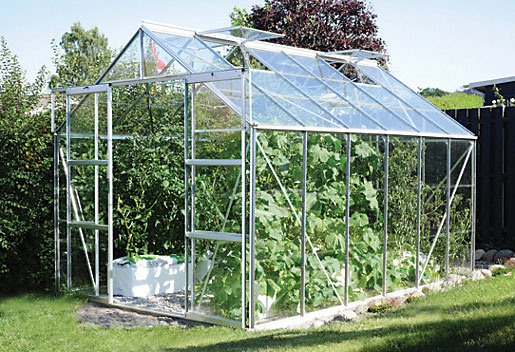Home » Blog » Greenhouse Glass - The Basics That You Need to Know
Posted on : 03-05-2021 Author : Sumeeta Roy

Apart from water, air, and nutrients, plants need warm temperatures and light to survive and grow. A greenhouse functions by fulfilling these two prerequisites as per their requirements. Therefore, a transparent material such as glass is used to build a greenhouse. This coined the term greenhouse glass.
What is Greenhouse Glass / Horticultural Glass?
Greenhouse or horticultural glass is a glass used to construct a greenhouse. It is preferred as a material for glazing (covering), as it allows more light to penetrate than polycarbonate or any other plastics. Glass remains clear throughout its lifespan. This is unlike plastics that are likely to become more scratched or translucent over time, decreasing the amount of light that plants get.
In this way, the interior of a greenhouse becomes considerably warmer than the external temperature, safeguarding its plants when it is cold. The amount of light penetrating is critical for the growth of your plants; the more it is, the better it is for your plants and greater is the yield.
Greenhouse glass is also known to conduct heat and allow the entry of ultraviolet rays in a greenhouse. This is how it helps in heating the greenhouse in summer to trigger tropical conditions.
The sun emits three basic light waves namely, infrared, visible light, and ultraviolet light waves. Due to a short wavelength, each one passes via most glasses, including greenhouse glass. When inside, the ground and plants absorb these waves. In plants, they are then utilized for photosynthesis and converted into thermal, or heat energy.
Greenhouse glass is the lowest glass grade, meaning it is available for sale at the lowest possible glass price. As a result, unlike float glass, there are chances of you spotting marks or blemishes in this glass. However, this does not any impact on its use of greenhouse glazing.
Greenhouse glass is available in the form of panels, each being only 3mm thick.
Normal or Toughened: Which is Better Greenhouse Glass?
Normal greenhouse glass is often compared with the toughened greenhouse glass. Both are types of greenhouse glass but the toughened one seems to be a better option.
Normal greenhouse glass is of 3mm thickness, affordable option available in two pieces per panel. The individual panes tend to overlap in the middle and then are clasp together. On the other hand, toughened safety glass is thicker (3mm or 4mm) and is quite stronger than the normal horticultural glass. It is used as long pane sheets for a cleaner finish without overlapping where, otherwise, moss and algae can buildup.
Toughened glass although heavier than polycarbonate and normal horticultural glass ensures great wind resistance. The wind simply cannot move it! This glass is made by using high temperature due to which tension is generated to obtain a hard output. Both heat-strengthening and tempering methods are used to toughen the glass. This hard glass can endure the impact of a football without any issue but not of a cricket or golf ball.
Upon breaking, horticulture glass will scatter into big sharp pieces that can hurt both plants and kids around. On the other hand, toughened greenhouse glass splits into tiny pieces upon breaking due to which there is no risk of injury.
Thus, the toughened greenhouse glass has gained more popularity, resulting in reduced sale prices.
Advantages and Disadvantages as Compared to Polycarbonate Glass
A competitive alternative to horticulture glass is polycarbonate, a tough plastic that too is used for making greenhouses. However, glass is increasingly becoming a more popular option despite being relatively costlier. Why so? Let’s find out!
Glass is the strongest of all build materials available for greenhouses. It is likely to last up to 50 years or even more! Glass greenhouses, however, cost more than polycarbonate options but are permanent. Even in terms of appearance, glass is a superior option for its transparency.
Glass greenhouses absorb maximum light, which means healthy yield. They also retain their clarity for years if you clean them frequently. Tripled- or double-planed or single-layer glass options are available to boost both ventilation and insulation, making greenhouse glass more competitive than polycarbonate options.